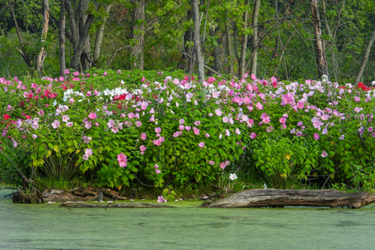Solutions In Bloom: How Flowers Are Being Used To Clean Up Polluted Waterways
By Ellie Gabel

Pollution and microplastics float down waterways that treatment plants have to manage. Alongside these contaminants are drifting flowers that clear aquatic habitats. Recent research shows they could be an organic method for removing phosphorus and nitrogen, yielding never-before-seen revenue for the floral market.
What Research Is There About Floating Flowers?
Tests in southern Florida experimented with floating treatment wetlands (FTWs) — human-made mechanisms meant to replicate the water-treating qualities of wetland ecosystems through phytoremediation. The plants and microbes that are most productive at isolating toxins are less plentiful, as anthropogenic climate change permanently alters how the biomes function.
Such research strives to supplement these depleting stores with rafts of hydroponically grown flowers. The devices protect the flowers from being damaged or drowning in the environment. Researchers regularly pulled the FTWs from the sites to review their effectiveness at collecting contaminants and verify pollutants did not reenter the waters.
Results were successful, though only marigolds out of four other species lasted the entire trial period of 12 weeks. They extracted 52% more phosphorus and 33% more nitrogen while producing 65 blooms during testing, signifying a hopeful future for marigold growers and wetland health. Other contenders included heat-tolerant sunflowers, dahlias, and zinnias.
How Do Floating Flowers Clean Pollutants?
The marigolds help clean waterways by acting as natural suction for undesirable elements. As the flowers grow with hydroponics, they can grip more from waterways than they would without additional technology.
Wetlands house many pollutants and countless nutrients for plant growth. It allowed researchers to run tests without fertilizer, meaning it would not need to be included in the hydroponic system. This was enough to make the flowers survive.
Researchers chose these cut flowers because they had several criteria. Their ability to flourish in Floridian climates was essential. However, they are all hyperaccumulators, meaning they can store high concentrations of heavy metals in their roots and tissues. The hydroponics encouraged extensive root system development, increasing their flowers’ capacities.
What happens to pruned and harvested blooms filled with metals? Several eco-conscious options exist to keep waterways and soil pollutant-free. Phytomining allows experts to extract the metals from plant biomass for repurposing. Other plants can perform phytovolatilization, transforming metals into gasses to release into the atmosphere.
What Additional Advantages Does The Process Provide?
Hydroponic and flower farmers in wetland areas will see business boom with the proliferation of this research. It could get more individuals into sustainable work, expanding local opportunities. However, the healing wetlands do more than remove pollutants and improve the quality of aquifers and reservoirs.
Eliminating the causes of pollution alleviates worldwide water scarcity, mainly for areas reliant on barrier island reservoirs or wetland stores for water access. Around 80% of global wastewater contains pollutants from inadequate treatment. Making it easier to filter and purify also reduces health crises in areas where treatment is less advanced. The FTWs directly support the United Nations Sustainable Development Goals for increasing clean water for all.
These strengthened habitats are necessary to defend against severe weather and natural disasters, primarily in coastal areas like barrier islands. Thicker foliage and more durable soil and sand keep erosion at bay to protect wetland species and biodiversity. Previously, polluted and chemical-ridden runoff seeped into nearby neighborhoods, tainting yards, agriculture, and septic systems.
The harmful algae populations create dead zones, eliminating so much oxygen and sunlight that life cannot flourish. Aquatic habitat preservation and biodiversity conservation require element and contaminant removal as quickly as possible. Though flowers cannot sap toxins and pollutants of all types, their capabilities provide a safe enough home for aquatic life to survive.
How Is The Field Of Study Developing?
The next step is to identify why the marigold was so successful, though early theories suggest it is their adventitious roots. They consume high nutrient quantities in flooded environments, so their biological resilience is ideal for advancement in the field while identifying other varieties for study. Streamlining raft blueprints and making them even more sustainable are other prospects.
Florida International University’s progress in FTWs reminds water treatment facilities, bioengineers, and climate activists that there are ways to manufacture natural solutions. Even if the organic materials are not plentiful enough to execute natural processes, innovators craft reliable mimics to complement nature.
 Ellie Gabel is a science writer specializing in environmental science and innovative technologies. She can be reached at ellie@revolutionized.com.
Ellie Gabel is a science writer specializing in environmental science and innovative technologies. She can be reached at ellie@revolutionized.com.
